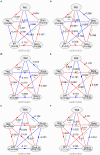Effects of soil water on fungal community composition along elevational gradients on the northern slope of the Central Kunlun Mountains
- PMID: 39845045
- PMCID: PMC11753354
- DOI: 10.3389/fmicb.2024.1494070
Effects of soil water on fungal community composition along elevational gradients on the northern slope of the Central Kunlun Mountains
Abstract
Soil fungi are essential to ecosystem processes, yet their elevational distribution patterns and the ecological mechanisms shaping their communities remain poorly understood and actively debated, particularly in arid regions. Here, we investigated the diversity patterns and underlying mechanisms shaping soil fungal communities along an elevational gradient (1,707-3,548 m) on the northern slope of the Central Kunlun Mountains in northwest China. Results indicated that the dominant phyla identified across the seven elevational gradients were Basidiomycota and Ascomycota, displaying a unimodal pattern and a U-shaped pattern in relative abundance, respectively. Soil saprotroph and nectar/tap saprotroph were the dominant functional groups (>1.0%). Along the elevational gradients, soil fungal α-diversity demonstrated a generally decreasing trend, whereas β-diversity showed a contrasting increasing trend. Among the environmental variables, altitude and climate (mean annual precipitation, MAP; mean annual temperature, MAT) were the strongest predictors for α-diversity. Partial least squares path modeling (PLSPM) analysis revealed that soil water content (Wat) was the most influential factor driving fungal α-diversity, while vegetation coverage (Veg) emerged as the primary determinant of soil fungal community composition. The influence of Wat on fungal α-diversity shifted from indirect to direct as elevation increased, transitioning from lower elevations (≤2,448 m) to higher elevations (≥2,746 m). Similarly, the impact of Veg on soil fungal community composition exhibited a comparable pattern. The null model analysis revealed that homogeneous selection and dispersal limitation dominated the soil fungal community assembly at elevations lower than 2,448 m and higher than 2,746 m, respectively. Variations in ecological processes may be linked to changes in key environmental factors that influence soil fungal communities in an elevation-dependent manner. These findings can enhance our ability to predict soil fungal diversity patterns and their responses to climate change in the ecosystems of the northern slope of the Central Kunlun Mountain.
Keywords: Central Kunlun Mountains; driving factors; ecological processes; elevational gradients; soil ecosystem.
Copyright © 2025 Zhang, Li, Zhang, Li, Zhang, Jiang, Islam, Li and Zeng.
Conflict of interest statement
The authors declare that the research was conducted in the absence of any commercial or financial relationships that could be construed as a potential conflict of interest.
Figures





References
-
- Abarenkov K., Nilsson R. H., Larsson K.-H., Taylor A. F., May T. W., Frøslev T. G., et al. . (2024). The UNITE database for molecular identification and taxonomic communication of fungi and other eukaryotes: sequences, taxa and classifications reconsidered. Nucleic Acids Res. 52, D791–D797. 10.1093/nar/gkad1039 - DOI - PMC - PubMed
-
- Allison S., Hanson C., Treseder K. (2007). Nitrogen fertilization reduces diversity and alters community structure of active fungi in boreal ecosystems. Soil. Biol. Biochem. 39, 1878–1887.
-
- Barrow N. J., Hartemink A. E. (2023). The effects of pH on nutrient availability depend on both soils and plants. Plant Soil 487, 21–37. 10.1007/s11104-023-05960-5 - DOI
LinkOut - more resources
Full Text Sources
Miscellaneous

